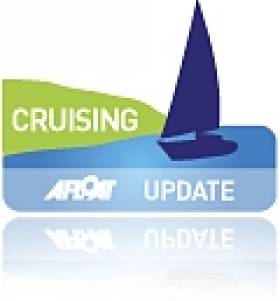Displaying items by tag: Adventure
#Adventure - An Irish duo have returned home after crossing the world's largest frozen lake in Russia.
As RTÉ News reports, Mike O'Shea from Dingle and Clare O'Leary from Bandon traversed the 640km-long Lake Baikal in Siberia over 26 days, contending with temperatures 30 degrees below freezing.
The challenge was the second mission in the veteran adventurer pair's 'Ice Project', an attempt to cross the world's main ice caps before the end of 2016.
Their next adventure will be a crossing of either Iceland or Greenland - where another intrepid group of Irish adventurers are headed this summer, as previously reported on Afloat.ie.
Meanwhile, rower Paul Gleeson writes in The Irish Times about his own upcoming challenge, joining three other men in a 25ft rowing boat to travel the 2,000 miles of the Northwest Passage in the Canadian Arctic.
Limerick man Gleeson, who is now based in Canada, compares the trek to the infamous Franklin Expedition through the passage in the mid 1800s - a tragic mission with an Irish connection through its second-in-command Francis Crozier.
The Irish Times has much more on the story HERE.
Irish Adventure Sailors Heading for the Arctic Circle
#arctic – A Galway to Greenland 2013 odyssey is underway as Irish adventurers are setting sail for the Arctic Circle this Summer. Preparations are currently underway for an ambitious and exciting expedition from Galway to Greenland this summer. Organised by Killary Adventure Expeditions, 'North of Disko' will see a crew of sailors, kayakers, climbers, a photographer and filmmaker set sail for the northwest coast of Greenland in mid June.
The crew aim to cover the 1500nm to Nuuk, the capital of Greenland, in about 14 days and then continue north, reaching Upernavik, well inside the Arctic Circle, a week later. From there, a team of four will set out on a 300km unsupported sea kayak, navigating through fjords and ice fields, while the team of three climbers will begin to tackle a series of first accents, as they follow the kayakers south.
Adding a further dimension to the expedition, photographer Daragh Muldowney aims to explore and capture the beauty of this spectacular coastline, with the aim of publishing a book and hosting an exhibition upon return. The entire expedition and its achievements will also be documented through film.
Leading the crew on board the 49ft, ex admirals cup racing yacht the 'Killary Flyer' is Jamie Young, whose previous expeditions include the successful Irish Cape Horn Sea Kayak Expedition in 1989, the Guinea Bissau Sea Kayak Expedition in 1992, and the 'South Aris' expedition, which attempted to re-enact Shackleton's epic boat trip from Elephant Island to South Georgia, in 1997.
The crew is mixed in age and experience and includes four young twenty-somethings embarking on the adventure of a lifetime, as well as seasoned kayakers Ali Donald, Kevin O'Callaghan and climber Collin Gibbon.
Further information on the expedition, crew and updates on preparations can be found at www.northofdisko.com
Sailing School Navigates Beyond the Gloom
The Principal John Moore has discounted all prices by 20 to 30%. All 2009 sailors returned in 2010 and brought friends with them. The French network of the newly appointed Director of Sailing Hugues Traonmilin has brought French families to the island and the French sailors were mixed with the Irish and British children and adults with great success. In addition to a busy summer season, 60 students of a South East College came for the very first time to the Sailing School in March 2010 as part of the Transition Year programme. They were hosted with full board accommodation at the Sailing School Guest house.
Definitely the location of the Sailing School plays a big part in this success story. Heir Island is located in the middle of Roaring Water Bay half way between Schull and Baltimore. Whatever direction you sail from the Sailing School beach, you'll encounter wonderful maritime landscapes and crystal clear waters. The Topaz dinghy fleet may sail to 3 or 4 different sandy beaches on one sailing day. The 3 Dublin Bay Mermaids sailing in flotilla explore the surrounding islands of Castle Island, Sherkin Island, the 3 Calves Islands and of course the Carthy's Islands to visit the seals colony.
Such a fantastic location has orientated the programme of this Sailing School towards the "Adventure" courses of the Irish Sailing Association. The school offers Adventure 1 & 2 courses as their "speciality" course.
2011 perspectives are already very encouraging with a second college to be hosted in Spring for a 10 day transition programme meanwhile the first one is returning after excellent feedback of the 2010 students and teachers. Being a family run business makes this small company very flexible and the range of their activities covers young sailors from 8 years old to adults, groups and families, on dinghies or on a traditional Heir Island Lobster Boat, and on kayaks if you don't want to sail. Also as a qualified Yachtmaster Instructor, the director of sailing has facilitated individually tailored sail training for yacht owners aboard their own yacht, an option that has proven both practical and successful.
More information HERE.
































































